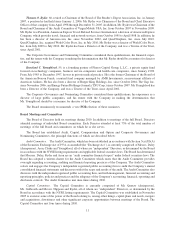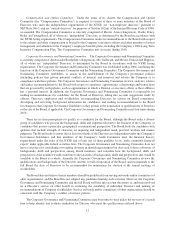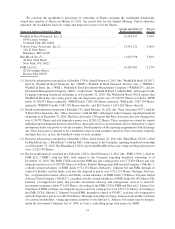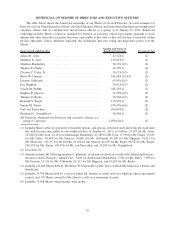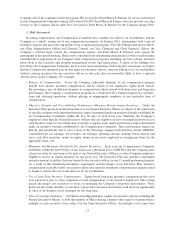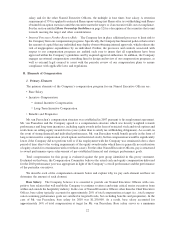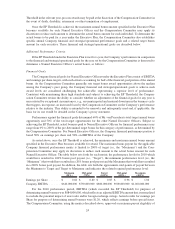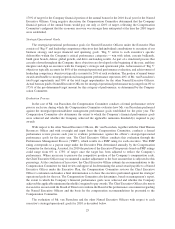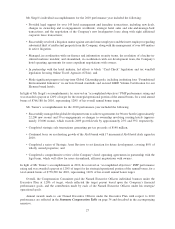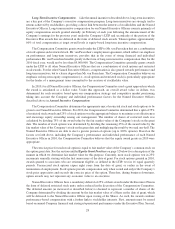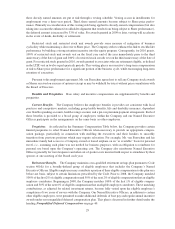Starwood 2010 Annual Report Download - page 32
Download and view the complete annual report
Please find page 32 of the 2010 Starwood annual report below. You can navigate through the pages in the report by either clicking on the pages listed below, or by using the keyword search tool below to find specific information within the annual report.goals. Further, when translating dollar-denominated long-term equity incentive awards into a number of stock
options to be granted under the Company’s 2004 Long-Term Incentive Compensation Plan (“LTIP”), the Com-
pensation Committee lowered the ratio from three times as many options as the number of Shares whose aggregate
value on the grant date equals the dollar-denominated award (i.e., a 3-to-1 ratio) to two and one-half times (i.e., a
2.5-to-1 ratio). These changes were designed to better align compensation with the creation and preservation of
stockholder value.
What the Program Intends to Reward. Our executive compensation program is strongly weighted toward
variable compensation tied to Company results. Specifically, our compensation program for our Named Executive
Officers is designed to ensure the following:
•Alignment with Stockholders: A significant portion of Named Executive Officer compensation is delivered
in the form of equity, ensuring that long-term compensation is strongly tied to stockholder returns.
•Achievement of Company Financial Objectives: A portion of Named Executive Officer compensation is
tied directly to the Company’s financial performance.
•Achievement of Strategic/Operational Objectives: A portion of Named Executive Officer compensation is
tied to achievement of specific individual objectives that are directly aligned with the execution of our
business strategy. These objectives may be related to, among others, operational excellence, brand
enhancement, innovation, growth, cost containment/efficiency, customer experience and/or teamwork.
•Overall Leadership and Stewardship of the Company: Leadership, teambuilding, and development of
future talent are key success factors for the Company and a portion of compensation for the Named
Executive Officers is dependent on satisfaction of core leadership competencies.
2. Roles and Responsibilities
The Compensation Committee is responsible for, among other things, the establishment and review of
compensation policies and programs for our executive officers and ensuring that the executive officers are
compensated in a manner consistent with the objectives and principles outlined above. It also monitors the
Company’s executive succession plan, and reviews and monitors the Company’s performance as it affects the
Company’s employees and the overall compensation policies for the Company’s employees.
The Compensation Committee makes all compensation decisions with respect to our Named Executive
Officers. Our Chief Executive Officer, together with the Chief Human Resources Officer, reviews the performance
of each other Named Executive Officer and presents to the Compensation Committee his conclusions and
recommendations, including salary adjustments and annual incentive compensation amounts (as described in
more detail in the Annual Incentive Compensation section below). The Compensation Committee may exercise its
discretion in modifying any recommended salary adjustments or awards to these executives.
The role of the Company’s management is to provide reviews and recommendations for the Compensation
Committee’s consideration, and to manage operational aspects of the Company’s compensation programs, policies
and governance. Direct responsibilities include, but are not limited to, (i) providing an ongoing review of the
effectiveness of the compensation programs, including competitiveness, and alignment with the Company’s
objectives, (ii) recommending changes, if necessary, to ensure achievement of all program objectives and
(iii) recommending pay levels, payout and/or awards for executive officers other than the Chief Executive Officer.
Management also prepares tally sheets which describe and quantify all components of total compensation for our
Named Executive Officers, including salary, annual incentive compensation, long-term incentive compensation,
deferred compensation, outstanding equity awards, benefits, perquisites and potential severance and change in
control payments. The Compensation Committee reviews and considers these tally sheets in making compensation
decisions for our Named Executive Officers.
The Compensation Committee retained Pearl Meyer & Partners to assist in the review and determination of
compensation awards to the Named Executive Officers (including the Chief Executive Officer) for the 2010
performance period, as well as the annual fees or other compensation paid to our Board. Pearl Meyer & Partners
worked with management and the Compensation Committee in reviewing the compensation structure of the
20



